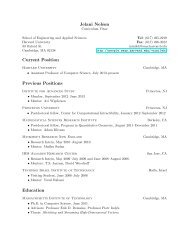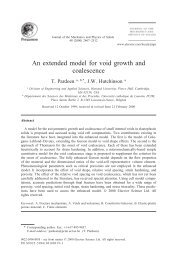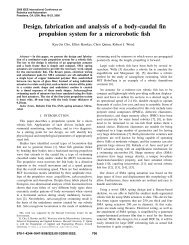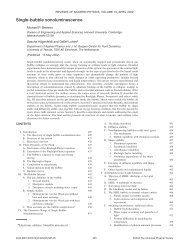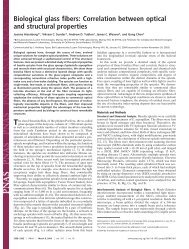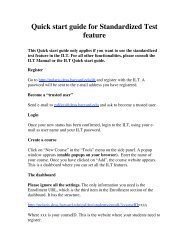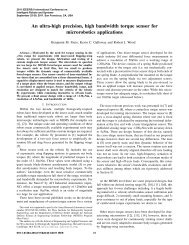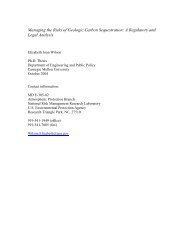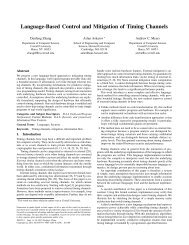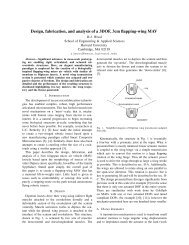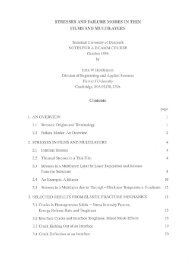CMOS RF Biosensor Utilizing Nuclear Magnetic Resonance
CMOS RF Biosensor Utilizing Nuclear Magnetic Resonance
CMOS RF Biosensor Utilizing Nuclear Magnetic Resonance
Create successful ePaper yourself
Turn your PDF publications into a flip-book with our unique Google optimized e-Paper software.
1632 IEEE JOURNAL OF SOLID-STATE CIRCUITS, VOL. 44, NO. 5, MAY 2009<br />
proteins, the magnetic particles self-assemble into larger magnets,<br />
which are even more efficient in increasing phase noise in<br />
the proton magnets’ precession, further accelerating dephasing,<br />
yielding the smallest . Thus, by monitoring , one can<br />
detect target objects [2].<br />
III. <strong>CMOS</strong> <strong>RF</strong> TRANSCEIVER IC DESIGN:<br />
CHALLENGES<br />
The NMR-based biosensing requires an NMR system that<br />
can faithfully measure . To this end, the 120 kg commercial<br />
benchtop system [3] [Section I] has been used. The main focus<br />
of this work is the drastic miniaturization of the NMR system,<br />
enabling the NMR-based biosensing in the portable form of<br />
Fig. 1. Here we describe challenges that lie in such miniaturization,<br />
and how we met them through our <strong>RF</strong> IC design.<br />
As seen in Fig. 2, any NMR system consists of a magnet,<br />
a coil, and an <strong>RF</strong> transceiver. By far the largest component is<br />
the magnet (e.g., the 120 kg weight of the benchtop system is<br />
largely due to a large magnet). Therefore, any effort to shrink an<br />
NMR system should start with using a small magnet. An NMR<br />
system with a small magnet, however, suffers from a reduced<br />
signal at the input of the receiver.<br />
To see this, we note that , induced in the coil due to the<br />
periodic variation of magnetic flux caused by the precession of<br />
, is proportional to the rate of change of flux, , and the<br />
total magnetization<br />
: the volume factors<br />
in here because is measured per unit volume. Since<br />
at room temperature 2 and ,wehave<br />
This equation explains why a small magnet yields a small<br />
. Firstly, in general a small magnet tends to produce a weak<br />
field , and is reduced with quadratic dependence on .<br />
Secondly, a smaller magnet exhibits a more pronounced field<br />
inhomogeneity. In the presence of field inhomogeneity, protons<br />
at different positions of the sample have different Larmor frequencies,<br />
and thus, they are excited at different frequencies. Although<br />
the <strong>RF</strong> pulse has other frequency components than<br />
due to its finite duration of , it still has a limited<br />
bandwidth 1 . Therefore, the pulse can efficiently<br />
excite only protons in the region where their Larmor frequencies<br />
fall within the bandwidth of the pulse. If the field inhomogeneity<br />
is increased with a smaller magnet, the spatial extent the<br />
pulse can excite is reduced, effectively reducing the sample<br />
volume in (3) thus decreasing , regardless of the physical<br />
sample size. One may increase the bandwidth of the excitation<br />
pulse by decreasing the signal duration , but this requires a<br />
larger [see (2)] and thus a larger transmitted signal power,<br />
which is electronically limited.<br />
In summary, with a small magnet, is substantially reduced<br />
and its detection requires a highly sensitive <strong>RF</strong> transceiver.<br />
For facile NMR experiments avoiding the stringent requirement<br />
for the <strong>RF</strong> transceiver, people have used large magnets,<br />
leading to the existing bulky NMR instrumentation.<br />
2 This well-established relation is derived from the Boltzmann’s law, which<br />
we will use without showing the derivation.<br />
(3)<br />
To achieve the drastic miniaturization, we took the opposite<br />
approach: we use a very small magnet the size of an adult fist<br />
(Fig. 1), and to detect the resulting, substantially reduced signal<br />
(amplitude: 130 nV; available power: 0.5 fW), we design<br />
a highly sensitive <strong>RF</strong> transceiver. By opting to use a very small<br />
magnet for miniaturization, we shifted the entire system design<br />
burden onto the <strong>RF</strong> transceiver design, which we successfully<br />
carried out. Furthermore, we integrated the <strong>RF</strong> transceiver onto<br />
a <strong>CMOS</strong> IC. As a very small, low cost magnet is used, the circuit<br />
integration makes sense: in a conventional system where a<br />
large, expensive magnet dominates the system size and cost, integration<br />
of the <strong>RF</strong> transceiver would hardly reduce either the<br />
system size or the cost.<br />
Our design also uses a planar microcoil on a glass substrate<br />
(Fig. 1), having in mind mass production of the coil via standard<br />
microfabrication techniques. As compared to commonly<br />
used solenoidal coils, the planar coil’s geometry does not allow<br />
effective induction of from precessing protons, which was<br />
partly the reason for the weak signal amplitude of 130 nV. Once<br />
again, we overcame this undesirable effect by the design of the<br />
highly sensitive <strong>RF</strong> transceiver.<br />
IV. <strong>CMOS</strong> <strong>RF</strong> TRANSCEIVER IC DESIGN:<br />
ARCHITECTURE<br />
Fig. 5 shows the architecture of our NMR <strong>RF</strong> transceiver IC,<br />
which we describe now. As our magnet has , the <strong>RF</strong><br />
design is based at the Larmor frequency of 21.3 MHz.<br />
A. Receiver Path<br />
Let us first focus on the receiver path in Fig. 5. The signal<br />
appearing at node is a weak echo signal whose available<br />
power is 0.5 fW. The bandwidth of the echo signal is determined<br />
by the faster -damping due to the field inhomogeneity, instead<br />
of the slower -damping due to the proton-proton interaction.<br />
As discussed in Section II-B, the bandwidth corresponding to<br />
the -damping is where signifies the fractional field<br />
inhomogeneity. As we have<br />
, the echo signal in the<br />
frequency domain (Fig. 5) is centered at the Larmor frequency<br />
21.3 MHz, with a bandwidth of kHz.<br />
The echo signal is amplified by a low noise amplifier, and<br />
then frequency down-converted using mixers and a local oscillator.<br />
Choosing the proper frequency for the local oscillator is<br />
a critical task in dealing with the weak echo signal. Let us denote<br />
the oscillator frequency as .If is set to zero, the<br />
down-converted signal at node is swamped by noise. On<br />
the other hand, if is too large, rejecting noise outside the signal<br />
bandwidth of 1.1 kHz after the frequency down-conversion is<br />
difficult, as it requires a high quality factor for the bandpass<br />
filter. Since the signal is very weak, rejecting out-of-band noise<br />
in order not to corrupt the signal-to-noise ratio (SNR) is a critical<br />
task. We select<br />
kHz, with which the down-converted<br />
signal is not centered at , but very close to (Fig. 5),<br />
facilitating out-of-band noise rejection using a bandpass filter<br />
with a moderate quality factor.<br />
As in any heterodyning receiver, image noise would add 3 dB<br />
to the receiver noise figure, unless suppressed. We incorporate<br />
an image rejection algorithm in the digital domain after the



